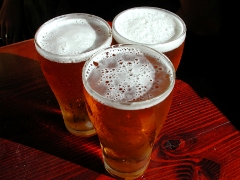American Amber Ale, also known in the Pacific Northwest as Red Ale is a uniquely American beer that is robust, rich and enjoyable. A fairly recent style, Ambers have become very popular with mainstream beer drinkers in the US. This week we take a look at the American Amber style, how to brew it at home and some examples of American Amber recipes.
 American Amber became popular in the Pacific Northwest before spreading nationwide, primarily through microbreweries and small regional brewers. These beers are also called Red Ales or West Coast Ales in some regions, and the style itself overlaps somewhat with American Pale Ale. However Amber ales have a stronger caramel flavor, more body, are darker and color and have a balance between bitterness and maltiness, where Pale Ales tend to have a stronger hop flavor. Amber ale is also popular in Australia, with the most popular being from Malt Shovel Brewery (James Squire Amber).
American Amber became popular in the Pacific Northwest before spreading nationwide, primarily through microbreweries and small regional brewers. These beers are also called Red Ales or West Coast Ales in some regions, and the style itself overlaps somewhat with American Pale Ale. However Amber ales have a stronger caramel flavor, more body, are darker and color and have a balance between bitterness and maltiness, where Pale Ales tend to have a stronger hop flavor. Amber ale is also popular in Australia, with the most popular being from Malt Shovel Brewery (James Squire Amber).
The American Amber Ale Style
The Amber style is considered somewhat richer than pale ale, and is recognized by the Beer Judge Certification Program (BJCP) as its own style (10-B). Ambers can have moderate to high hop flavor, but the hops should not be dominant. American hops are most often use which can result in a somewhat citrusy flavor. Malt sweetness and a caramel flavor are desirable, but Amber should not have the roasted character of a brown ale. Few esters and no dicetyl is desirable.
Stronger versions may have some alcohol warmth, but the finish should be smooth. Medium to full body for the beer is normal, with moderate to high carbonation. The BJCP specifies an original gravity of 1.045-1.060 and final gravity of 1.010-1.015 giving 4.5-6.2% alcohol by volume.
Bitterness is between 25-40 IBUs, giving an average bitterness ratio of 0.619 BU/GU which places amber ales slightly on the malty side as far as overall balance. Color is amber to copper brown, with an SRM of 10-17, though some mass produced ambers run at the low end of the color range.
Ambers are moderate to highly carbonated – and typically have good head retention.
Brewing an Amber Ale
Amber Ale is traditionally made with American two row pale malt as the base, making up 60-85% of the grain bill. Medium to dark crystal malts are used to provide color and caramel flavor, typically making up 10-20% of the grain bill. Small amounts of other specialty grains such as a tiny amount of roast malt (for red color versions), aromatic malt, carafoam, munich or victory malts may be used to add unique character to the brew.
There is no fixed water profile associated with Amber ale, so a variety of waters can be used. However, as the water does not add significantly to the flavor for this style, a moderate water profile (not too high in sulfates or carbonates) is desirable.
American hops are traditionally used, with citrus varieties such as centennial being popular. Like pale ale, it is not unusual to use multiple hop additions during the boil as well as a moderate amount of fresh dry hops to provide some hoppy aroma, though overall the beer should be well balanced, with the balance slightly to the malty side.
As a full body Amber is desirable, one generally uses a full bodied single step infusion mash with the conversion step at 156-158F for approximately 45 minutes to an hour. Since the beer is generally 100% barley malt, no special techniques are needed.
Most amber ales are fermented with American ale yeast, which provides a fairly clean finish with high attenuation. Some of the more robust and rich Ambers may also feature use of lighter English ale yeasts that can contribute low to moderate esters and complexity to the beer without unbalancing it. Ambers are fermented and aged at normal ale temperatures (64-68F), and should be bottled or kegged with moderate to medium-high carbonation.
Amber Ale Recipes
Here are a few Amber Ales from our BeerSmith recipe archive:
- Awesome Amber – Extract
- Max’s Last Call – All Grain
- No Sense of Decency Amber – Partial Mash
- Oatmeal Amber – Extract
- Full Sail Ale? – Extract
- Libertyish Cascade – Extract
I hope you enjoy your American Amber! Thank you again for joining us here at the BeerSmith Home Brewing Blog. Please subscribe for many more free articles, news, and the latest in homebrewing.
Hi there friends, good piece of writing and good arguments
commented here, I am genuinely enjoying by these.
Budwiser has put out a beer called Black Crown which I enjoy. The bottle says amber ale, bu I don’t know the difference. I want to try and brew some of m own in that category. Have yo tried it or what would b a good recipe to start with ?
Budweiser , black crown , is it a true Amber ale if so do u know a recipe close to it ?
Budweiser Black Crown is an Amber Lager, not ale, and it’s pretty bad: http://www.beeradvocate.com/beer/profile/29/88582/
Cheers!
Pingback: Amber Ale and Red Ale, the Craft Beer of choice?
Great article,Brad. I have modified a few of my APA recipes in BeerSmith to brew an Amber. Lots of fun and good beer. I’ve ended up with some delightfully hoppy Ambers. Real Autumn crowd pleaser